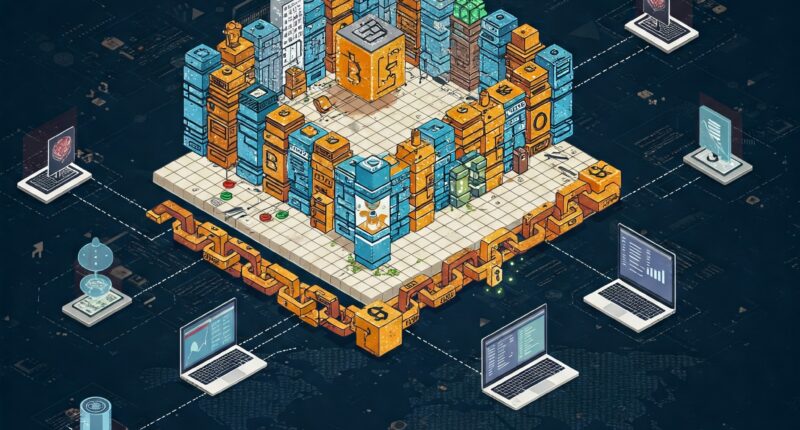At first glance, the term blockchain might sound abstract: just a ‘block’ and a ‘chain’. But beneath this simple name lies a groundbreaking technology: a decentralized, distributed, and tamper-proof digital ledger. Imagine a shared spreadsheet, duplicated across thousands of computers worldwide. Every new transaction is recorded as a ‘block,’ which is then cryptographically linked to the previous one, forming an unbreakable ‘chain’. Secured by complex math, this system makes altering past records nearly impossible without the entire network’s consensus.
The origins: Solving a digital dilemma
Long before Bitcoin, the seeds of blockchain were planted. In 1982, cryptographer David Chaum proposed a blockchain-like protocol in his dissertation. A decade later, researchers Stuart Haber and W. Scott Stornetta advanced the idea, creating a system to timestamp digital documents securely. By 1992, they incorporated Merkle trees — a method to bundle multiple records into a single block — boosting efficiency. Yet, these innovations remained largely theoretical.
The real breakthrough came in 2008, when an anonymous figure (or group) named Satoshi Nakamoto published ‘Bitcoin: A Peer-to-Peer Electronic Cash System’. This whitepaper introduced a decentralized digital currency, free from banks or governments. Bitcoin’s blockchain solved a critical flaw in digital money: the double-spending problem (where the same funds could be spent twice). By linking transaction blocks in a cryptographically secured sequence, the system ensured transparency and immutability.
On January 3, 2009, the first Bitcoin block — the ‘Genesis Block’ — was mined, marking the birth of blockchain as we know it.
How blockchain works: The pillars of trust
Blockchain’s power comes from five key principles:
- Decentralization
Unlike traditional databases controlled by a single entity, blockchain operates across a network of computers (nodes). No single point of failure exists, making it resistant to censorship and hacking. - Immutability
Once a block is added to the chain, altering it requires changing every subsequent block— a near-impossible feat without majority network approval. - Transparency
Public blockchains allow anyone to view transactions (though identities remain pseudonymous), fostering accountability. - Consensus mechanisms
Networks rely on agreed-upon rules to validate transactions. Bitcoin uses Proof-of-Work (PoW), where miners solve complex puzzles. Newer blockchains often use Proof-of-Stake (PoS), where validators ‘stake’ coins to participate. - Cryptography
Advanced encryption ensures data integrity. Each block contains a unique hash (like a digital fingerprint), and transactions are verified via digital signatures.
Beyond Bitcoin: Blockchain’s expanding universe
While Bitcoin introduced blockchain, the technology has since exploded into countless applications—dubbed ‘Blockchain 2.0’. Here’s where it’s making waves today:
- Finance (DeFi)
Decentralized Finance platforms enable lending, borrowing, and trading without banks, using smart contracts. - Supply chains
Companies like Walmart use blockchain to track food origins, reducing fraud and ensuring safety. - Healthcare
Patient records can be securely shared across providers while maintaining privacy. - Digital identity
Users control their online identities, reducing reliance on vulnerable centralized systems. - NFTs and digital ownership
Non-fungible tokens (NFTs) verify authenticity for art, music, and even real estate. - Voting systems
Blockchain could eliminate election fraud by providing a transparent, auditable trail.
The future: challenges and opportunities
Blockchain is evolving rapidly, with several trends shaping its trajectory:
- Interoperability
Projects like Polkadot and Cosmos aim to connect disparate blockchains, enabling seamless data exchange. - Scalability fixes
Solutions like Layer-2 networks (e.g., Bitcoin’s Lightning Network) speed up transactions while reducing costs. - Enterprise adoption
Businesses are testing private blockchains for logistics, contracts, and fraud prevention. - Regulation
Governments are racing to create policies that balance innovation with consumer protection. - Web3 and the decentralized internet
Blockchain underpins Web3, a vision for a user-owned internet where data isn’t controlled by tech giants.
A technology still unfolding
From its humble beginnings as Bitcoin’s backbone, blockchain has grown into a force reshaping finance, governance, and beyond. Its core strengths — transparency, security, and decentralization — offer solutions to some of the digital age’s biggest challenges. Yet hurdles remain, including energy concerns (for PoW systems) and regulatory uncertainty.
One thing is clear: blockchain is more than a buzzword. It’s a paradigm shift: one that’s still writing its story. Whether you’re a skeptic or an enthusiast, understanding its potential is key to navigating the future of technology.





